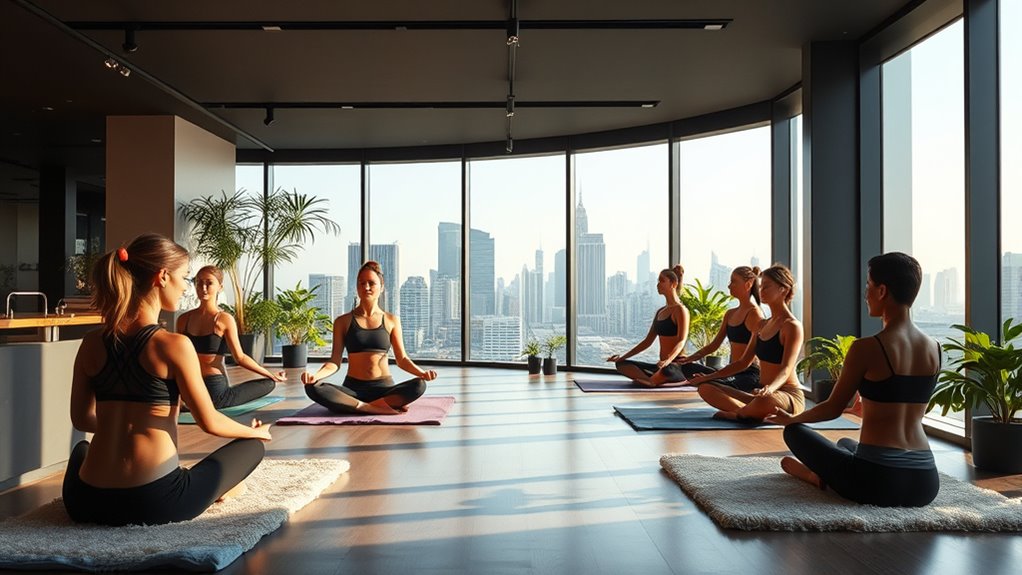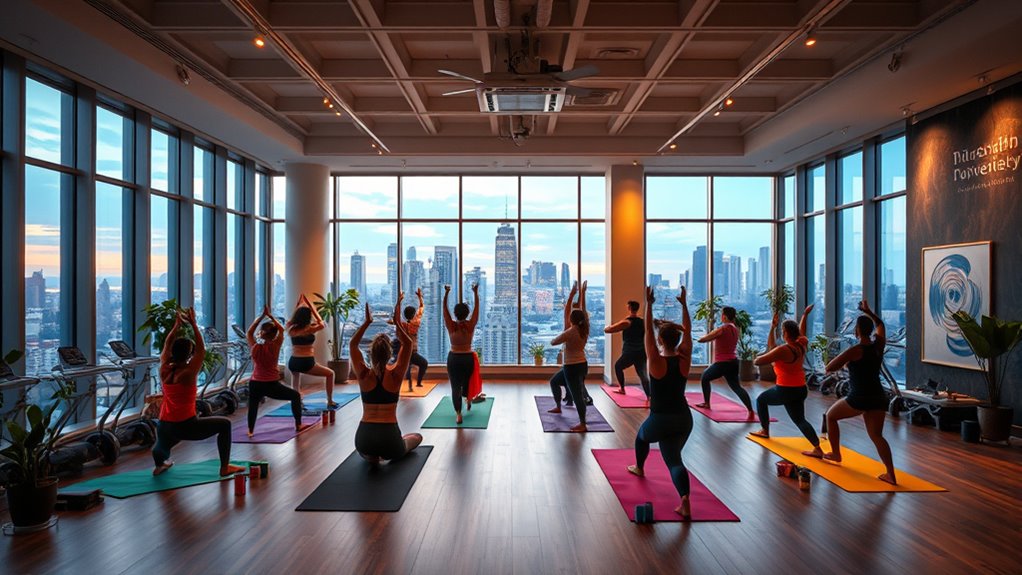Wellness clubs in modern cities hold significant cultural value by fostering a sense of community, prioritizing mental and physical health, and promoting inclusivity. They help you connect with others who share similar well-being goals and encourage social cohesion through group activities and events. These spaces reflect a broader shift toward holistic health and mindfulness in urban living. To understand how these clubs influence city life and social norms, keep exploring their evolving role in shaping modern urban culture.
Key Takeaways
- Wellness clubs embed holistic health practices into urban routines, reflecting a cultural shift toward prioritizing mental and physical well-being.
- They foster social cohesion by creating inclusive spaces for community engagement and shared health goals.
- Wellness spaces influence city culture by promoting active participation in outdoor and social wellness activities.
- They democratize access to health resources, emphasizing inclusivity across diverse socioeconomic and demographic groups.
- Wellness clubs symbolize modern urban values of mindfulness, community, and holistic self-care, shaping broader social norms.

In modern cities, wellness clubs have become essential havens for busy individuals seeking to improve their physical and mental health. These spaces aren’t just about fitness; they serve as indispensable centers for mindfulness practices that help you slow down and reconnect with yourself amid the urban hustle. When you step into a wellness club, you’re often encouraged to embrace mindfulness—focusing on your breath, body, and thoughts—to cultivate a sense of calm and clarity. This emphasis on mindfulness isn’t accidental; it reflects a broader cultural shift toward holistic well-being. You find that these clubs foster environments where mental health is prioritized equally with physical health, making them imperative for city dwellers juggling packed schedules and constant stimuli.
Community engagement plays a pivotal role in the cultural significance of wellness clubs. These spaces aren’t isolated; they thrive on the connections you build with others who share similar health goals or wellness philosophies. Through group classes, workshops, or casual social events, you become part of a community that supports your journey toward better health. This sense of belonging goes beyond individual workouts—it helps you feel rooted in your city, creating bonds that often extend outside the club walls. In a way, wellness clubs act as social hubs where shared experiences foster a collective sense of well-being, reinforcing the idea that health is a communal effort, not just a personal pursuit.
Moreover, wellness clubs influence city culture by integrating wellness into daily life. They often host events or initiatives that promote community engagement outside their walls—such as outdoor yoga sessions in parks or charity fitness runs. These activities encourage you to participate actively in your community, promoting social cohesion and a healthier urban environment. As you engage more, you realize that wellness isn’t confined to individual practice; it’s embedded in the fabric of city life, shaping social norms around health and self-care.
The cultural importance of wellness clubs also stems from their role in democratizing access to health resources. They provide a space where diverse populations can come together regardless of socioeconomic background, fostering inclusivity and mutual support. When you see a variety of people—different ages, backgrounds, fitness levels—using these spaces, it becomes clear that wellness is a shared value. This inclusivity helps redefine city living as more than just fast-paced routines; it becomes a community effort to promote well-being, mental resilience, and social connection. Ultimately, wellness clubs in modern cities aren’t just about individual health—they embody a collective movement toward a more mindful, engaged, and healthier urban culture.
Frequently Asked Questions
How Do Wellness Clubs Influence Local Community Cohesion?
Wellness clubs boost local community cohesion by fostering social bonding and encouraging community engagement. When you join a wellness club, you connect with others who share your health goals, creating a sense of belonging. Participating in group classes or events helps build trust and camaraderie, strengthening neighborhood ties. As you become more involved, you contribute to a supportive environment that promotes collective well-being and unity within your community.
What Are the Environmental Impacts of Wellness Club Facilities?
You might think wellness clubs are eco-friendly, but they can have significant environmental impacts. They often rely on sustainable architecture to reduce their footprint, yet energy consumption from lighting, HVAC systems, and equipment can be high. This “adds fuel to the fire” by increasing carbon emissions. To minimize impact, clubs are adopting green practices like solar power and energy-efficient designs, helping them stay in tune with environmental conservation efforts.
How Do Wellness Trends Vary Across Different Cultures?
You’ll notice wellness trends differ across cultures, shaped by unique cultural practices and traditional healing methods. In some societies, practices like yoga or meditation are rooted in spiritual traditions, while others emphasize herbal remedies or acupuncture. These variations reflect deep-seated beliefs about health and well-being, influencing how wellness is approached. Embracing these diverse trends helps you appreciate the rich cultural tapestry that shapes modern wellness practices worldwide.
What Role Do Wellness Clubs Play in Urban Mental Health Strategies?
Wellness clubs play a crucial role in urban mental health strategies by offering mental health support and fostering social engagement. You can find spaces where you feel connected and supported, reducing stress and loneliness. These clubs promote mindfulness, resilience, and community, helping you manage urban pressures. By encouraging social interaction and mental wellness activities, they become essential in creating healthier, more supportive city environments.
How Accessible Are Wellness Clubs for Underserved Populations?
Wellness clubs often struggle with accessibility for underserved populations due to high membership affordability and lack of cultural inclusivity. You might find that these clubs are primarily designed for more privileged groups, making it tough for others to join. To improve access, clubs need to lower costs and embrace diverse cultural practices, ensuring everyone feels welcome and can benefit from wellness initiatives.
Conclusion
As you step into these wellness clubs, you realize they’re more than just gyms—they’re gateways to something deeper. You feel the pulse of a city that’s redefining health and community in ways you never expected. What’s coming next could change how we all view well-being forever. Are you ready to be part of this transformation? The future of wellness in modern cities is unfolding now, and you won’t want to miss what’s just around the corner.









